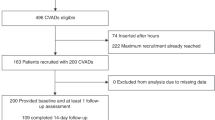Abstract
Objective
Identification of early mechanical complications (EMC) of central venous catheterizations (CVC) in pediatric patients and determination of EMC risk factors.
Design
Prospective observational study.
Setting
Pediatric intensive-care unit in a university hospital.
Patients and measurements
Eight-hundred and twenty-five CVC were performed in 546 patients. Age, weight, gender, mechanical ventilation, analgesia, resident CVC failure, CVC indication, admission diagnosis, emergency or scheduled procedure, type of catheter (diameter, lumen number), catheter final location, number of attempts, and EMC were recorded. Risk factors for EMC were determined by multivariate analysis.
Results
Median patient age was 22.0 months (0–216 months). CVC was an emergency procedure in 421 (51%) cases, scheduled in 336 (40.7%), and guide-wire exchanged in 68 (8.2%). There were 293 (35.5%) internal jugular, 116 (14.1%) subclavian, and 416 (50.4%) femoral catheters. CVC was performed by staff physicians in 35.8% cases, supervised residents in 43.4%, and staff after resident failure in 20.8%. 151 EMC occurred in 144 CVC (17.5%). The most commons EMC were arterial puncture (n = 60; 7.2%), catheter malposition (n = 39; 4.7%), arrhythmias (n = 19; 2.3%), and hematoma (n = 12; 1.4%). Resident failure to perform CVC (OR 2.53; CI 95% 1.53–4.16), high venous access (subclavian or jugular) (OR 1.91; CI 95% 1.26–2.88), and number of attempts (OR 1.10; CI 95% 1.03–1.17) were independently associated with EMC.
Conclusions
EMC of CVC were common in a teaching university hospital, but severe complications were very uncommon. Resident failure to perform CVC, high venous access, and number of attempts were independent risk factors for EMC of CVC.
Similar content being viewed by others
References
Smith-Wright DL, Green TP, Lock JE, Egar MI, Fuhrman BP (1984) Complications of vascular catheterization in critically ill children. Crit Care Med 12:1015–1017
Polderman KH, Girbes AJ (2002) Central venous catheter use. Part 1. Mechanical complications. Intensive Care Med 28:1–17
Casado-Flores J, Barja J, Martino R, Serrano A, Valdivielso A (2001) Complications of central venous catheterization in critically ill children. Pediatr Crit Care Med 2:57–62
Schummer W, Schummer C, Rose N, Niesen WD, Sakka SG (2007) Mechanical complications and malpositions of central venous cannulations by experienced operators: a prospective study of 1,794 catheterizations in critically ill patients. Intensive Care Med 33:1055–1059
Cruzeiro PC, Camargos PA, Miranda ME (2006) Central venous catheter placement in children: a prospective study of complications in a Brazilian public hospital. Pediatr Surg Int 22:536–540
Sheridan RL, Weber JM (2006) Mechanical and infectious complications of central venous cannulation in children: lessons learned from a 10-year experience placing more than 1,000 catheters. J Burn Care Res 27:713–718
Ayas NT, Norena M, Wong H, Chittock D, Dodek PM (2007) Pneumothorax after insertion of central venous catheters in the intensive-care unit: association with month of year and week of month. Qual Saf Health Care 16:252–255
Citak A, Karabocuoglu M, Ucsel R, Uzel N (2002) Central venous catheters in pediatric patients—subclavian venous approach as the first choice. Pediatr Int 44:83–86
Johnson EM, Saltzman DA, Suh G, Dahms RA, Leonard AS (1998) Complications and risks of central venous catheter placement in children. Surgery 124:911–916
Seldinger SI (1953) Catheter replacement of the needle in percutaneous arteriography; a new technique. Acta Radiol 39:368–376
Menendez S, Campuzano S, Medina A, Rey C, Concha A, Los Arcos M (2004) Nonsurgical removal of a knotted pediatric femoral vein catheter. J Pediatr 144:683
Alvarado-Diez MA, Marquez-Enriquez LM, Troconis-Trens G, Serrano V, Vasquez-Gutierrez E, Rivera-Rebolledo JC et al (1993) Experience in the use of central venous catheterization via subclavian puncture in a pediatric hospital. Bol Med Hosp Infant Mex 50:394–398
Mansfield PF, Hohn DC, Fornage BD, Gregurich MA, Ota DM (1994) Complications and failures of subclavian-vein catheterization. N Engl J Med 331:1735–1738
Merrer J, De Jonghe B, Golliot F, Lefrant JY, Raffy B, Barre E et al (2001) Complications of femoral and subclavian venous catheterization in critically ill patients: a randomized controlled trial. JAMA 286:700–707
Sitzmann JV, Townsend TR, Siler MC, Bartlett JG (1985) Septic and technical complications of central venous catheterization. A prospective study of 200 consecutive patients. Ann Surg 202:766–770
Garcia-Teresa MA, Casado-Flores J, Delgado Dominguez MA, Roqueta-Mas J, Cambra-Lasaosa F, Concha-Torre A et al (2007) Infectious complications of percutaneous central venous catheterization in pediatric patients: a Spanish multicenter study. Intensive Care Med 33:466–476
Karapinar B, Cura A (2007) Complications of central venous catheterization in critically ill children. Pediatr Int 49:593–599
Iovino F, Pittiruti M, Buononato M, Lo SF (2001) Central venous catheterization: complications of different placements. Ann Chir 126:1001–1006
Casado-Flores J, Valdivielso-Serna A, Perez-Jurado L, Pozo-Roman J, Monleon-Luque M, Garcia-Perez J et al (1991) Subclavian vein catheterization in critically ill children: analysis of 322 cannulations. Intensive Care Med 17:350–354
Bonventre EV, Lally KP, Chwals WJ, Hardin WD Jr, Atkinson JB (1989) Percutaneous insertion of subclavian venous catheters in infants and children. Surg Gynecol Obstet 169:203–205
de Jonge RC, Polderman KH, Gemke RJ (2005) Central venous catheter use in the pediatric patient: mechanical and infectious complications. Pediatr Crit Care Med 6:329–339
Gebhard RE, Szmuk P, Pivalizza EG et al (2007) The accuracy of electrocardiogram-controlled central line placement. Anesth Analg 10:65–70
Abood GJ, Davis KA, Esposito TJ, Luchette FA, Gamelli RL (2007) Comparison of routine chest radiograph versus clinician judgment to determine adequate central line placement in critically ill patients. J Trauma 63:50–56
Bishop L, Dougherty L, Bodenham A, Mansi J, Crowe P, Kibbler C et al (2007) Guidelines on the insertion and management of central venous access devices in adults. Int J Lab Hematol 29:261–278
Hernandez-Hernandez MA, Suberviola-Canas B, Cabello-Najera MM (2006) Importance of checking central venous catheter tip location by X-ray. Arch Bronconeumol 42:154–155
Haas NA (2004) Clinical review: vascular access for fluid infusion in children. Crit Care 8:478–484
Mallinson C, Bennett J, Hodgson P, Petros AJ (1999) Position of the internal jugular vein in children. A study of the anatomy using ultrasonography. Paediatr Anaesth 9:111–114
Araujo CC, Lima MC, Falbo GH (2007) Percutaneous subclavian central venous catheterization in children and adolescents: success, complications and related factors. J Pediatr (Rio J) 83:64–70
Lefrant JY, Muller L, De La Coussaye JE, Prudhomme M, Ripart J, Gouzes C et al (2002) Risk factors of failure and immediate complication of subclavian vein catheterization in critically ill patients. Intensive Care Med 28:1036–1041
Acknowledgments
The authors gratefully acknowledge the assistance of the medical and nursing staff of the Hospital Universitario Central de Asturias PICU.
Author information
Authors and Affiliations
Corresponding author
Rights and permissions
About this article
Cite this article
Rey, C., Álvarez, F., De La Rua, V. et al. Mechanical complications during central venous cannulations in pediatric patients. Intensive Care Med 35, 1438–1443 (2009). https://doi.org/10.1007/s00134-009-1534-0
Received:
Accepted:
Published:
Issue Date:
DOI: https://doi.org/10.1007/s00134-009-1534-0




